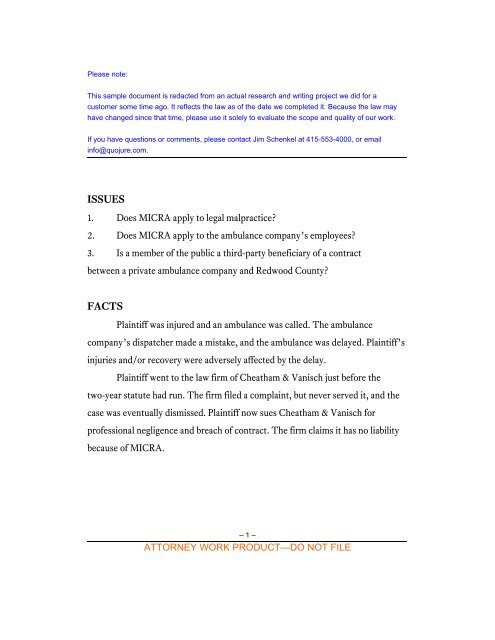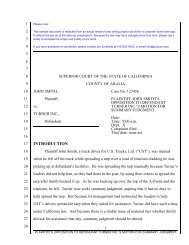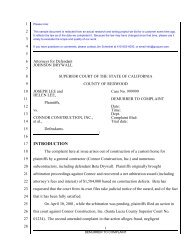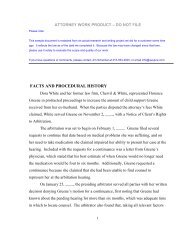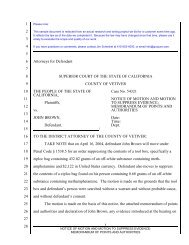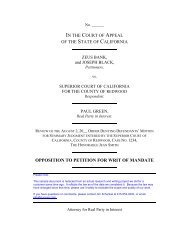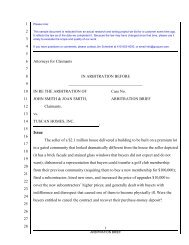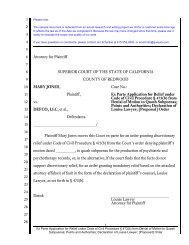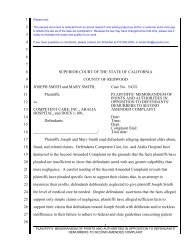Memo re MICRA - Quo Jure Corporation
Memo re MICRA - Quo Jure Corporation
Memo re MICRA - Quo Jure Corporation
Create successful ePaper yourself
Turn your PDF publications into a flip-book with our unique Google optimized e-Paper software.
Please note:<br />
This sample document is <strong>re</strong>dacted from an actual <strong>re</strong>search and writing project we did for a<br />
customer some time ago. It <strong>re</strong>flects the law as of the date we completed it. Because the law may<br />
have changed since that time, please use it solely to evaluate the scope and quality of our work.<br />
If you have questions or comments, please contact Jim Schenkel at 415-553-4000, or email<br />
info@quoju<strong>re</strong>.com.<br />
ISSUES<br />
1. Does <strong>MICRA</strong> apply to legal malpractice?<br />
2. Does <strong>MICRA</strong> apply to the ambulance company’s employees?<br />
3. Is a member of the public a third-party beneficiary of a contract<br />
between a private ambulance company and Redwood County?<br />
FACTS<br />
Plaintiff was inju<strong>re</strong>d and an ambulance was called. The ambulance<br />
company’s dispatcher made a mistake, and the ambulance was delayed. Plaintiff’s<br />
injuries and/or <strong>re</strong>covery we<strong>re</strong> adversely affected by the delay.<br />
Plaintiff went to the law firm of Cheatham & Vanisch just befo<strong>re</strong> the<br />
two-year statute had run. The firm filed a complaint, but never served it, and the<br />
case was eventually dismissed. Plaintiff now sues Cheatham & Vanisch for<br />
professional negligence and b<strong>re</strong>ach of contract. The firm claims it has no liability<br />
because of <strong>MICRA</strong>.<br />
– 1 –<br />
ATTORNEY WORK PRODUCT—DO NOT FILE
DISCUSSION<br />
1. <strong>MICRA</strong> application to law firm<br />
No authority was found for the proposition that <strong>MICRA</strong> governs legal<br />
malpractice actions. The <strong>MICRA</strong> provisions a<strong>re</strong> sprinkled throughout various<br />
code sections. As an example, Civil Code § 3333.1 applies to “health ca<strong>re</strong><br />
providers” in actions for “professional negligence.” It defines “health ca<strong>re</strong><br />
provider” as<br />
any person licensed or certified pursuant to Division 2 (commencing<br />
with § 500) of the Business and Professions Code, or licensed<br />
pursuant to the Osteopathic Initiative Act, or the Chiropractic<br />
Initiative Act, or licensed pursuant to Chapter 2.5 (commencing<br />
with Section 1440) of Division 2 of the Health and Safety Code; and<br />
any clinic, health dispensary, or health facility, licensed pursuant to<br />
Division 2 (commencing with Section 1200) of the Health and<br />
Safety Code.<br />
It defines “professional negligence” as<br />
a negligent act or omission to act by a health ca<strong>re</strong> provider in the<br />
<strong>re</strong>ndering of professional services, which act or omission is the<br />
proximate cause of a personal injury or wrongful death, provided<br />
that such services a<strong>re</strong> within the scope of services for which the<br />
provider is licensed and which a<strong>re</strong> not within any <strong>re</strong>striction<br />
imposed by the licensing agency or licensed hospital.<br />
(Emphasis added.)<br />
Since lawyers a<strong>re</strong> clearly not health ca<strong>re</strong> providers, professional negligence by a<br />
lawyer cannot be cove<strong>re</strong>d by <strong>MICRA</strong>.<br />
2. <strong>MICRA</strong> application to EMS company<br />
The ambulance company will be protected by the <strong>MICRA</strong> limitations.<br />
Cannister v. Emergency Medical Service (2008) 160 Cal.App.4th 388. The plaintiff<br />
– 2 –<br />
ATTORNEY WORK PRODUCT—DO NOT FILE
in Cannister, a police officer, was riding in the back of an ambulance, escorting a<br />
person under ar<strong>re</strong>st to the hospital. The ambulance was in an accident, injuring<br />
the officer and ending his ca<strong>re</strong>er. The officer sued the ambulance company for<br />
negligence. The trial court subjected the plaintiff’s case to <strong>MICRA</strong> limitations by<br />
allowing evidence of collateral payments. Plaintiff appealed, arguing that EMS<br />
workers a<strong>re</strong> not health ca<strong>re</strong> providers and that the ambulance driver was not<br />
providing health ca<strong>re</strong> services at the time of the accident. Id. at 395.<br />
The appellate court found that EMS workers a<strong>re</strong> health ca<strong>re</strong> providers and<br />
that the EMS Company is protected by <strong>MICRA</strong> even when the EMS is me<strong>re</strong>ly<br />
driving the ambulance. “The services that EMT’s provide to patients a<strong>re</strong><br />
‘inextricably identified’ with the health of patients, and an ambulance company<br />
vicariously assumes the same standing with such patients through its licensed<br />
employees.” Id. at 404. The EMS company itself would have the same protection<br />
as its licensed employees, hence <strong>MICRA</strong> would apply to the EMS company even<br />
for its dispatcher’s negligence. Id. at 404.<br />
To satisfy the second prong for coverage under <strong>MICRA</strong>, the conduct<br />
complained of must constitute “professional negligence.” The <strong>MICRA</strong> statutes<br />
define “professional negligence” as negligence that occurs while the health ca<strong>re</strong><br />
provider is providing services that a<strong>re</strong> “within the scope of services for which the<br />
provider is licensed.” Civ. Code, §§ 3333.1, subd. (c)(2), 3333.2, subd. (c)(2);<br />
Code Civ. Proc., §§ 340.5, 364, subd. (f)(2), 667.7, subd. (e)(4), 1295, subd.<br />
(g)(2); Bus. & Prof. Code, § 6146, subd. (c)(3). He<strong>re</strong>, the dispatcher’s negligence<br />
occur<strong>re</strong>d while the health ca<strong>re</strong> provider (the EMTs) we<strong>re</strong> providing services that<br />
we<strong>re</strong> within the scope of services for which they we<strong>re</strong> licensed. Indeed, the<br />
Cannister court held that, as a matter of law, the act of operating an ambulance to<br />
– 3 –<br />
ATTORNEY WORK PRODUCT—DO NOT FILE
transport a patient to or from a medical facility is encompassed within the term<br />
“professional negligence.” Id. at 404.<br />
3. Third-party beneficiary theory<br />
A third-party beneficiary theory probably will not work in this situation.<br />
Civil Code § 1559 governs third-party beneficiary law:<br />
A contract, made exp<strong>re</strong>ssly for the benefit of a third person, may be<br />
enforced by him at any time befo<strong>re</strong> the parties the<strong>re</strong>to <strong>re</strong>scind it.<br />
This section excludes enforcement of a contract by persons who a<strong>re</strong><br />
only incidentally or <strong>re</strong>motely benefited by it. A third party may<br />
qualify as a beneficiary under a contract whe<strong>re</strong> the contracting<br />
parties must have intended to benefit that third party and such<br />
intent appears on the terms of the contract. Whether a third party is<br />
an intended beneficiary or me<strong>re</strong>ly an incidental beneficiary to the<br />
contract involves construction of the parties’ intent, gleaned from<br />
<strong>re</strong>ading the contract as a whole in light of the circumstances under<br />
which it was ente<strong>re</strong>d. A third party should not be permitted to<br />
enforce covenants made not for his benefit, but rather for others. He<br />
is not a contracting party; his right to performance is p<strong>re</strong>dicated on<br />
the contracting parties [sic] intent to benefit him.<br />
(Emphasis added.)<br />
He<strong>re</strong>, the contract between Redwood County and EMS provider most<br />
likely p<strong>re</strong>cludes third-party beneficiary status. For instance, the contract being<br />
forwarded with this memo contains exp<strong>re</strong>ss provisions indicating that the<strong>re</strong> a<strong>re</strong> no<br />
third party beneficiaries to the contract. Even if these a<strong>re</strong> not the exact contracts<br />
in effect when plaintiff was inju<strong>re</strong>d, the terms of the contract that was in effect a<strong>re</strong><br />
likely similar. In addition, a <strong>re</strong>view of several other California contracts between<br />
municipalities and EMS companies contained similar language p<strong>re</strong>cluding thirdparty<br />
beneficiaries.<br />
– 4 –<br />
ATTORNEY WORK PRODUCT—DO NOT FILE


